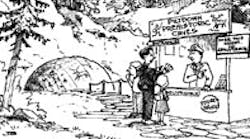Tall tale
Problem 167 — Getting stuck in the middle can be a real headache, as this month’s problem by V. Sharma of Houston demonstrates. “Certainly I’m going on the tour,” quipped Timothy McSqueal. “I paid for three tickets, and you can’t expect me to send my children in alone!” The scene was the famous Piltdown Prehistoric Cave. McSqueal had brought his two children to see the chalk drawings on the wall. Unfortunately the ceiling of the cave was relatively low, and people over a certain height could not go on the tour. The cave was a low, smooth, perfect arc of a circle that joined a perfectly level floor. After a number of arguments, it turned out, McSqueal could walk down the middle with his head just touching the ceiling. His 4-ft, 2-in. son could walk at a distance of 12 ft, 6 in. from either side where the arc met the floor (if you were looking at a cross-section of the cave), and his 3-ft, 4-in. daughter, 9 ft, 2 in. from either side where the arc meets the floor. (Note: these distances are measured along the floor.) Their heads also just touched the ceiling at these distances. How tall is McSqueal?
Technical consultant: Jack Couillard, Menasha, Wis.
Solution to last month’s problem 166 — You chose the path of least resistance if you answered 100 Ω. Here’s how to network:
To find the equivalent resistance from Point A to Point B, find the applied voltage across A to B. This is the sum of the individual voltages of each leg on a path from A to B.
Let A, B, C, and D be corners on the parallelepiped as indicated. Let R1 →12 be the 12 resistors on the legs of the parallelepiped.
Since the network is balanced, if a 3-A current flows into A, it will be divided into three 1-A currents that flow into resistors: R1, R2, and R3. At Point C the current will divide again, and currents of ½ A will flow into resistors R6 and R11.
A current of 3 A must flow out of B, therefore the currents in R8, R10, and R12 flowing into B are 1 A. Now we can calculate a voltage drop using Kirchhoff’s Laws. You can choose any path that gets you from A to B. Let’s take the path through R2, R11, and R12:
By Kirchhoff’s Voltage Law, the algebraic sum of the voltages around a loop at any instant is zero.
VAB =V2 +V11 +V12
Since we know the currents in each resistor and that each resistor has a resistance of 120 V, we can use Ohm’s Law to solve for the applied voltage. (Ohm’s Law states that the current in a circuit is directly proportional to the total voltage acting in the circuit and inversely proportional to the total resistance in the circuit.) Let I1 →12 be the individual currents in each resistor:
VAB = I2R2 + I11R11 + I12R12
VAB = (1 A ×120 Ω) 1(½ A ×120 Ω) 1(1 A ×120 Ω)
VAB = 300 V
Since the total current at Point B is 3 A and applied voltage is 300 V, we can use Ohm’s Law again to solve for the resistance:
Zapp’s dropout rate was a charged issue.
Contest winner — Congratulations to Mart Martinson of Deerfield Beach, Fla., who won our September contest by having his name drawn from the 12 contestants who answered correctly out of a total of 48 for that month. A TI-68 calculator is in the mail to him.
The TI-68 Advanced Scientific Calculator by Texas Instruments can solve five simultaneous equations with real and complex coefficients and has 40 number functions that can be used in both the rectangular and polar coordinate systems. Other functions include formula programming, integration, and polynomial root finding. The calculator also features a last-equation replay function that lets you doublecheck your work.


